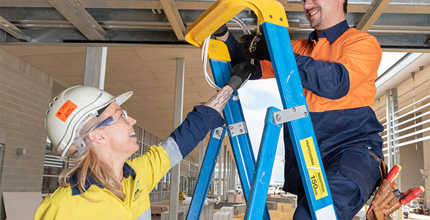Safety Alert 124 | Line of fire

What is “Line of Fire”?
Line of Fire refers to situations where workers are at risk of injury due to being in the path of moving objects, equipment, or the sudden release of energy. This includes being struck by tools or components, caught between moving parts or structures, or exposed to electrical energy that can arc, flash, or discharge unexpectedly. These types of incidents can happen quickly and without warning, often when routine tasks are done without proper hazard awareness or controls in place.
As an electrical apprentice it is crucial to recognise these hazards early, respond with caution and prepare accordingly. Electrical work often involves risks that are not always visible, such as stored energy or hidden conductors, making situational awareness and safety procedures critical.
Examples
Some examples of line of fire risks that can be present in electrical work include:
- Standing or walking in front of moving vehicles or reversing plant
- Being in the swing zone of an EWP, excavator, or crane
- Dropped tools or materials while working at height
- Sudden movement or snapback of cables during pulling or tensioning
- Hands or fingers placed near pinch points during lifting or fitting tasks
- Hands or fingers holding objects while using hand tools to terminate or modify e.g. switches and outlets
Avoiding Line of Fire hazards
Preventing line of fire incidents starts with planning through tasks and having good safety habits:
- Plan before you start: always complete a RAC before beginning a new task and review Safe Work Method Statements (SWMS) and Job Hazard Analysis (JHA’s).
- Stay visible: wear hi-vis and make eye contact with plant operators before entering work zones.
- Stay clear: think through what might move, release, or shift during your task, and what direction it might go, and stay clear of it.
- Never assume: don’t ever think that equipment is safe to work on without verifying proper isolation yourself.
- Wear your PPE: make sure it’s the right type for the task—this includes gloves, ear plugs or muffs, glasses and face protection. If you need to hold something to terminate or modify it, wear a glove on the hand holding the item.
- Keep tools pointed away: don’t put tools in the line of fire of your body and others, especially when using screwdrivers, cutters, strippers, or any other sharp instruments.
- Working at height or in ceiling spaces: make sure all tools and materials are properly secured to prevent them from falling and becoming a strike hazard.
Hierarchy of controls
When controlling hazards, start by trying to eliminate them altogether, for example, de-energising circuits before starting work is the most effective way to remove risk. If elimination isn’t possible, look to engineer the risk out through insulation, guarding, or barriers. Administrative controls like safe work method statements (SWMS), permits to work, and regular safety meetings also play a key role in managing hazards. PPE should always be worn, but remember PPE is your last line of defence, not your first.
- Eliminate - e.g. isolate and de-energize equipment
- Substitute - use safer tools or materials when possible
- Isolate - sources of energy, tag and lockout electrical circuits, tie down/up things that might move
- Engineer Controls - guards, barriers, insulation, tool lanyards
- Administrative Controls - signage, training, permits, procedures
- PPE - always wear correct PPE for the task
Conclusion
Whether you’re working in a ceiling space, on a live site with mobile plant, or up in an EWP, the “line of fire” is a serious risk that can come from any direction. Staying alert, using the right controls, and communicating with your team can help to prevent injuries or incidents from occurring.
As an Electrical Apprentice, you are often placed in fast-paced environments, so it’s important to speak up, ask questions, and never put yourself in a position where something or someone can hit, strike, or trap you.
For further information regarding this Safety Alert, please contact EGT on (08) 6241 6100 or talk to your Field Officer.
















